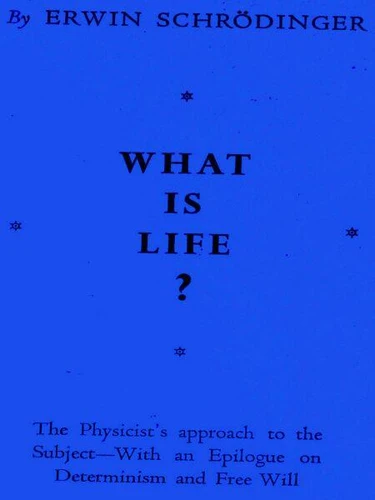- Accueil /
- Erwin Schrödinger
Erwin Schrödinger
Erwin Schrödinger (1887-1961) est né à Vienne (Autriche). Ses recherches en physique aboutissent en 1926 à "l'équation de Schrödinger", élément central de la théorie quantique. Il obtient le prix Nobel en 1933, et est également connu pour avoir formulé le "paradoxe du chat de Schrödinger" qui affecte la théorie quantique de la mesure. Prix Nobel de la Physique
Erwin Schrödinger (1887-1961) est né à Vienne (Autriche). Ses recherches en physique aboutissent en 1926 à "l'équation de Schrödinger", élément central de la théorie quantique. Il obtient le prix Nobel en 1933, et est également connu pour avoir formulé le "paradoxe du chat de Schrödinger" qui affecte la théorie quantique de la mesure. Prix Nobel de la Physique

Dernière sortie
What Is Life? The Physical Aspect Of The Living Cell
''What Is Life? The Physical Aspect of the Living Cell'' is a science book written for the lay reader by the physicist Erwin Schrödinger. The book was based on a course of public lectures delivered by Schrödinger. Schrödinger's lecture focused on one important question: "how can the events in space and time which take place within the spatial boundary of a living organism be accounted for by physics and chemistry?"
In the book, Schrödinger introduced the idea of an "aperiodic solid" that contained genetic information in its configuration of covalent chemical bonds.
In the 1940s, this idea stimulated enthusiasm for discovering the chemical basis of genetic inheritance. Although the existence of some form of hereditary information had been hypothesized since 1869, its role in reproduction and its helical shape were still unknown at the time of Schrödinger's lecture. In 1953, James D. Watson and Francis Crick jointly proposed the double helix structure of deoxyribonucleic acid (DNA) on the basis of, amongst other theoretical insights, X-ray diffraction experiments conducted by Rosalind Franklin.
They both credited Schrödinger's book with presenting an early theoretical description of how the storage of genetic information would work, and each independently acknowledged the book as a source of inspiration for their researches.
In the 1940s, this idea stimulated enthusiasm for discovering the chemical basis of genetic inheritance. Although the existence of some form of hereditary information had been hypothesized since 1869, its role in reproduction and its helical shape were still unknown at the time of Schrödinger's lecture. In 1953, James D. Watson and Francis Crick jointly proposed the double helix structure of deoxyribonucleic acid (DNA) on the basis of, amongst other theoretical insights, X-ray diffraction experiments conducted by Rosalind Franklin.
They both credited Schrödinger's book with presenting an early theoretical description of how the storage of genetic information would work, and each independently acknowledged the book as a source of inspiration for their researches.
''What Is Life? The Physical Aspect of the Living Cell'' is a science book written for the lay reader by the physicist Erwin Schrödinger. The book was based on a course of public lectures delivered by Schrödinger. Schrödinger's lecture focused on one important question: "how can the events in space and time which take place within the spatial boundary of a living organism be accounted for by physics and chemistry?"
In the book, Schrödinger introduced the idea of an "aperiodic solid" that contained genetic information in its configuration of covalent chemical bonds.
In the 1940s, this idea stimulated enthusiasm for discovering the chemical basis of genetic inheritance. Although the existence of some form of hereditary information had been hypothesized since 1869, its role in reproduction and its helical shape were still unknown at the time of Schrödinger's lecture. In 1953, James D. Watson and Francis Crick jointly proposed the double helix structure of deoxyribonucleic acid (DNA) on the basis of, amongst other theoretical insights, X-ray diffraction experiments conducted by Rosalind Franklin.
They both credited Schrödinger's book with presenting an early theoretical description of how the storage of genetic information would work, and each independently acknowledged the book as a source of inspiration for their researches.
In the 1940s, this idea stimulated enthusiasm for discovering the chemical basis of genetic inheritance. Although the existence of some form of hereditary information had been hypothesized since 1869, its role in reproduction and its helical shape were still unknown at the time of Schrödinger's lecture. In 1953, James D. Watson and Francis Crick jointly proposed the double helix structure of deoxyribonucleic acid (DNA) on the basis of, amongst other theoretical insights, X-ray diffraction experiments conducted by Rosalind Franklin.
They both credited Schrödinger's book with presenting an early theoretical description of how the storage of genetic information would work, and each independently acknowledged the book as a source of inspiration for their researches.
Les livres de Erwin Schrödinger

5,12 €

0,99 €

L'Esprit et la matière. (précédé de) L'Élision, essai sur la philosophie d'E. Schrödinger
Michel Bitbol, Erwin Schrödinger
E-book
8,99 €

L'Esprit et la matière. (précédé de) L'Élision, essai sur la philosophie d'E. Schrödinger
Michel Bitbol, Erwin Schrödinger
E-book
8,99 €

42,00 €

29,00 €

22,50 €